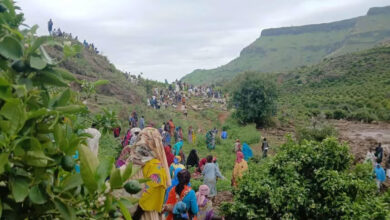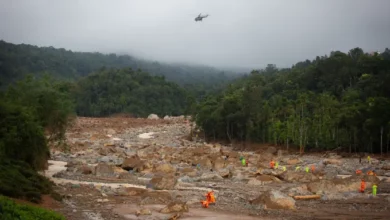
A deadly landslide in the mountains of Papua New Guinea, near where Exxon Mobil is building a US$15.7 billion gas project, has raised new questions about the global energy industry's scramble for ever harder-to-reach resources.
The landslide tore through a quarry used by Exxon in January, killing at least 25 people in the poor South Pacific country, but it has stirred little international publicity, even though an expert report had questioned the safety of the excavations.
The controversy also raises some familiar issues aired by critics of "big oil" in previous disasters: a pressure to deliver results, contractors found to have cut corners and remote operations that limit government oversight.
Exxon, which was using the quarry to produce rock and gravel needed to develop the upstream end of its gas-export project, has said it is unclear what caused the disaster in Papua New Guinea's steep, heavily wooded Southern Highlands.
The Papua New Guinea government has denied the quarry contributed to the landslide, but local residents, environmental activists and an international landslide expert are unconvinced and want a thorough, independent investigation — something that shows no sign of happening despite evidence that quarrying work was being rushed to meet tight construction deadlines.
Less than a year before the landslide, an independent consultant, Italian firm D'Appolonia, found Exxon's quarrying operations did not meet the environmental and social standards demanded by the company's creditors and it concluded that workers had been under pressure to meet deadlines.
"The overall impression of [the consultant] is that incidents and situations have developed because the project has circumvented correct procedures in the interest of schedule," D'Appolonia said in a report dated March last year and commissioned by the project's main creditors.
"The project will need to make sure that schedule does not dominate decisions," it added.
The report, compiled by a firm that also counts Italian energy group Eni and the European commission among its clients, was sitting in a corner of Exxon's website when a mountainside collapsed above one of several quarries Exxon was running in and around the site.
A villager recalled hearing a loud crack ring out across the valley as the slope gave way, collapsing through the Tumbi quarry and burying homes that had been perched beneath it. The disaster left a trail of debris stretching more than 500 meters and also carved through a road into the project.
All of the bodies of those killed remain buried in the debris, according to the provincial governor.
"I have never seen this type of [landslide] before in my life in that area," the villager, Hipson Puma, 39, said by telephone.
Exxon said it had closed the Tumbi quarry in August last year, five months before the landslide, because it no longer needed to use it and had taken heed of the D'Appolonia report, making the site secure. It also notes that landslides are common in that part of the Southern Highlands.
"This was a significant landslide, and we, like many others, want to know how it occurred so we can understand the environment in which we'll be operating, given we'll be in this region for many years to come," spokesperson Rebecca Arnold said, when asked if Exxon would support an independent inquiry.
Exxon operates the project and owns 33.2 percent of it. Australian companies Oil Search and Santos also hold significant stakes, with 29 percent and 13.5 percent respectively, while the state-run National Petroleum Company of Papua New Guinea owns 16.8 percent. Japan's Nippon Oil Exploration has 4.7 percent and local landowner group Mineral Resources Development Company 2.8 percent.
D'Appolonia also said, in a later report, that conditions at the Tumbi quarry had improved by August.
But some locals say Exxon had expanded the quarry too rapidly — a charge it denies — and they are using the March report to support their claim that the oil company was to blame.
The Exxon spokesperson said she did not have information on how much the quarry had been expanded. The company had planned to relocate 14 households to make way for the works at the site, which had been used for smaller excavations for many years before it reopened for the project in 2010. A map of the original plans for the site show it intended to double its size in terms of area over 24 months. It used the quarry for 15 months.
David Petley, director of Durham University's International Landslide Centre, said poorly managed quarries and mines often contributed to large landslides and that a thorough investigation could help prevent future disasters.
"My working hypothesis, which needs to be tested, is that the quarry played a role in increasing the susceptibility of the slope to failure. Rainfall was then the trigger for the final collapse," said Petley, a geography professor who has offered to help with any investigation.
"The fact that problems with [the quarry's] operation had been identified by independent consultants strengthens that possibility, but it remains far from certain without a proper investigation," Petley added.
The Papua New Guinea government, a part-owner of the development, the nation's largest ever, has given no indication that it will conduct an independent inquiry into the disaster.
The Papua New Guinea National Disaster Center conducted what it calls an "initial report," concluding that the trigger for the landslide was heavy rainfall. It does not mention whether or not the quarry had been ruled out or had even been considered as a contributing factor to the landslide.
The center, which is responsible for recommending a more detailed investigation, says a landslide of that magnitude had not occurred in Papua New Guinea since 1998. But the center's chief, Martin Mose, said there were no plans for an inquiry.
He gave no clear reason.
"There is still not discussion of a detailed investigation," Mose said last month by phone from Port Moresby, the capital.
"We haven't sanctioned anything yet. An investigation of that magnitude can be taken later on," he said, without giving a timeframe. He added that it was up to the government, not independent experts, to carry out any full investigation.




